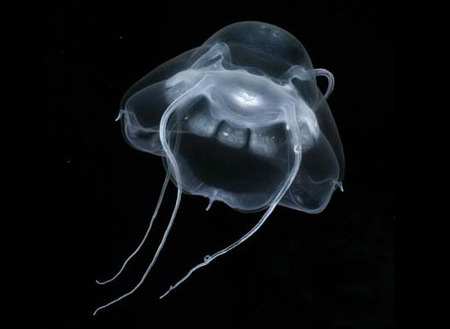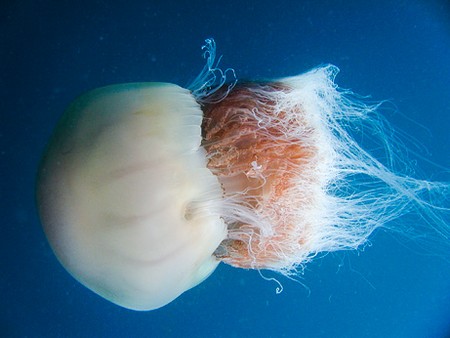Jellyfish is a sea creature having a jellylike or gelatinous body and long thin parts called tentacles. Jellyfish use these tentacles to catch prey and for defense as they sting with these tentacles when threatened. Generally speaking, jellyfish are harmless sea creatures which are found all across the world. There are more than one thousand species of jellyfish found across the world. Out of these over one thousand species, there are some which are commonly found and few are rare ones. These are found floating from cold waters to warm tropical waters.
According to Smithsonian Magazine, there are more than 2000 species of jellyfish found in the world. This article is an attempt to describe some of the most common types of jellyfish. Hope you will like the information provided in this article about this gelatinous sea creature.
Aequorea Victoria: Aequorea Victoria is a jellyfish popular with a name crystal jellyfish. It is called crystal jellyfish because of its shinny, translucent appearance. This jellyfish has a great role to play in the science. It is rich in a protein content known as GFP, which has already been used in numerous experiments together with the formation of the rabbit that glows in the black lights. Apart from this, GFP is also used to study the cell processes with a view to treat fatal health issues such as Alzheimer’s. The presence of this protein gives this jellyfish a cool fluorescent blue green color.
Australian Box Jellyfish: Jellyfish are dangerous at times. You have heard this phrase a lot many times. But not all the jellyfish are dangerous as the one we are describing here. Yes! Australian box jellyfish is known to be the most dangerous species of jellyfish among others and it is for this reason it is also known as a Sea Wasp. Although, it is quite hard to spot this jellyfish because of its transparent looks, it has a scary looks once spotted. You first instance may force you to think that you have encountered a mutant. It has multiple eyeballs on its stomach and a cube shape rather than regular dome-shape.
Bathykorus Bouilloni: This species is discovered just a decade earlier. It is found in the deep sea waters, especially in the Arctic region. The major reason behind its increasing popularity within a short period of time is its appearance like Darth Vader. If we analyze it scientifically, we will come to know that this jellyfish has four primary tentacles, four secondary tentacles, and three interradial manubrial pouches within each quadrant.
Costa Rican Jellyfish: Scientifically called Stauromedusae, which may be because of its resemblance to serpent-haired Medusa, an excellent description of the species. It is commonly found in the waters of Costa Rica. The water there has a temperature of about six hundred degrees. This species live at about the depth of 8,000 feet in the water. This species of jellyfish is found in dark pink color.
Flower Hat Jelly: Its scientific name is Olindias Formosa. It is given the name of flower hat jelly because of its appearance like having a neon pink flower hat on the top of its head. It is a beautiful species of jellyfish with amazing looks. These amazing looks are achieved by those purple and orange hues along with the neon pink. The major habitat of this species is that waters of Brazil and Argentina. However, it can also be seen occasionally in Japanese waters as well. This species of jellyfish is smaller in size, i.e. about six inch.
Foot Long Tentacles Jellyfish: According to Smithsonian Magazine, there is a species of jellyfish which is about twelve inch in length and found in the frozen waters of West Antarctic. It is also assumed that this species of jellyfish can live in the waters of Costa Rica with a water temperature of about six hundred degrees.
Moon Jellyfish: Moon jellyfish is one of the most commonly known species of jellyfish. It is moon jellyfish which is normally kept in the aquariums. The other names given to this jellyfish is Saucer jellyfish and Common jellyfish and scientifically it is known as Aurelia Aurita. It has a translucent body, which is 25-40 cm in diameter. It is easily identified by the presence of four horseshoe-shaped sex glands (gonads) which can be seen easily from atop the bell. This species of jellyfish has a classical looks of a jellyfish. It is certainly a good-looking jellyfish that fascinates the eyes of the people.
Normura’s Jellyfish: Have you ever imagined of a jellyfish that is far bigger than your own size. This species of a jellyfish is on according to your imagination. Surprisingly, this species of jellyfish can be as big as the length of 100 feet and over six feet in diameter. Certainly, it has a huge eye-popping size for a human being. An average of this jellyfish can be around 450 pounds. These are found along the coast of Japanese water.
Phialella Zappai: There is an interesting fact about this jellyfish which certainly make you smile when you come to know about it. If you closely, examine the name of this jellyfish, you will most likely come to know that it is named after a popular musician Frank Zappa. Now, you may be wondering what a musician has to do with this jellyfish. Let me describe you the fact behind it. The scientist who discovered this species was a big fan of Zappa and he literally wrote a letter to Zappa that he was naming this jellyfish after his name. After that they both had a meeting as well.
Rhopilema Esculentum: This is a species of jellyfish which is popular as an edible fish. It is widely cultured in China where it is used in myriad of recipes and dishes. It is important to mention here that the stings of this species are considered harmful to humans but still it is safe enough to consume these jellyfish.
Above mentioned are some of the different species of jellyfish which are known for their own characteristic features. It is a certainly a great and amazing sea creature which is apparently harmless for the humans. These remain harmless unless these are not threatened by the humans otherwise they may use their tentacles to sting the humans. This soft, mushy, and spongy type sea creature certainly has something to admire in them.


